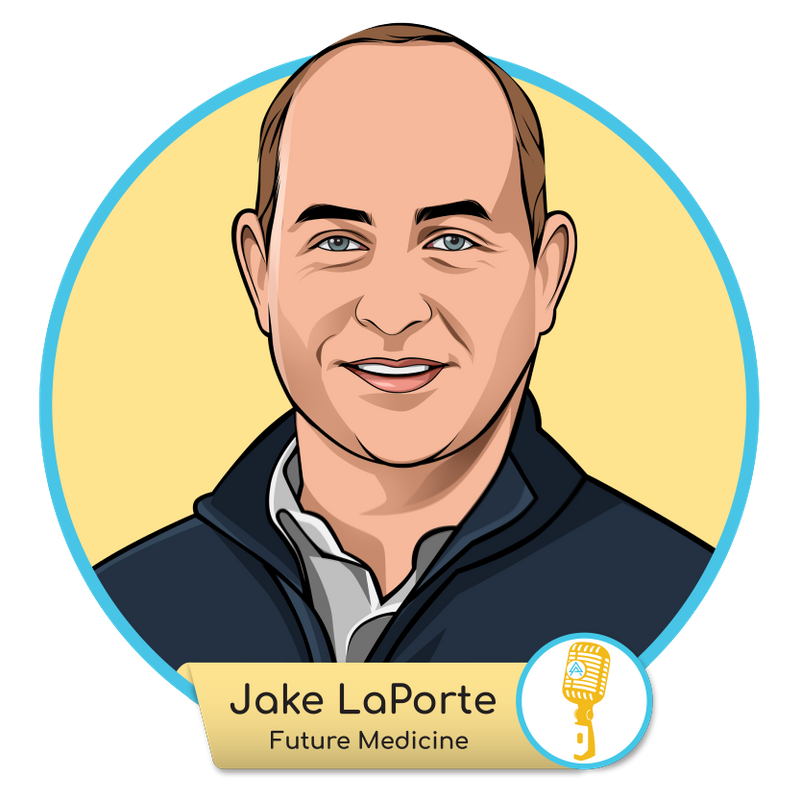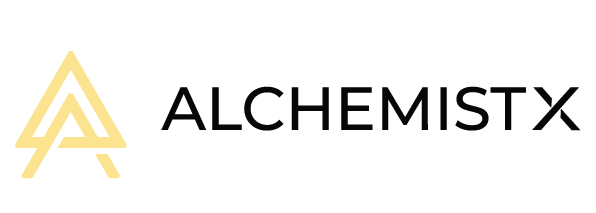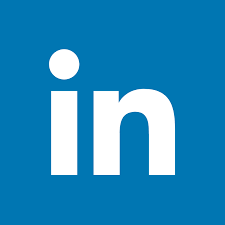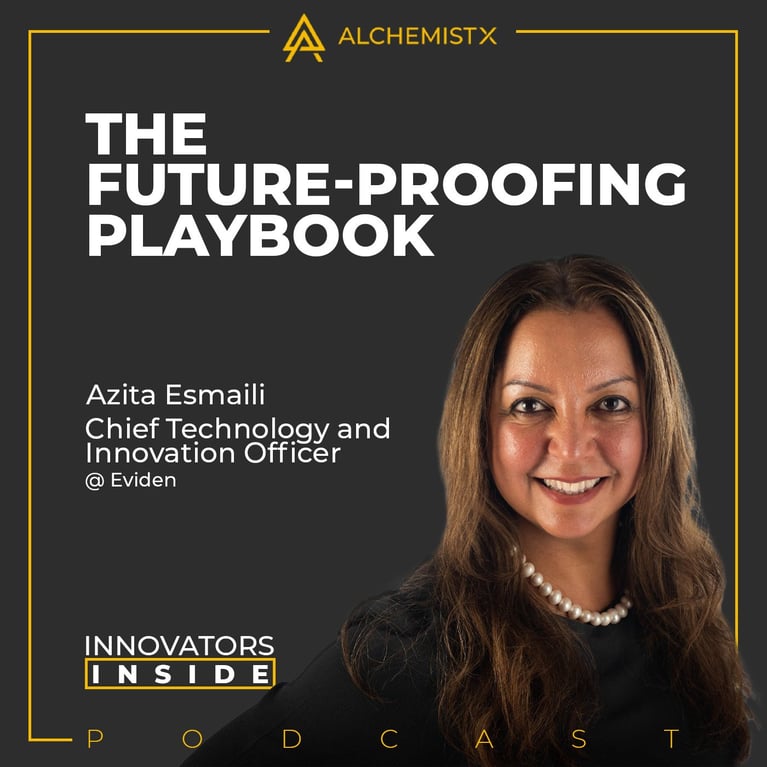Azita Esmaili, Chief Technology and Innovation Officer at Eviden explores the dynamic interplay between AI, innovation management, and future-proofing organizations.

AlchemistX: Innovators Inside
E.19 - Jacob Laporte: Future Medicine
Published on
September 16, 2021
"We need to transcend the traditional corporate structure - reduce the sometimes difficult journey to get collaboration in place." - Jacob LaPorte
Show Notes
Rachel Chalmers:
Today, I am delighted to welcome to the show Dr. Jacob Laporte. A former Harvard chemist and McKinsey consultant. Jake founded and leads the Biome by Novartis, the company's first ever externally branded innovation lab with hubs in Hyderabad, London, Montreal, Nuremberg, San Francisco, Sao Paulo, Shanghai and Singapore. Before founding Biome, Jake led digital strategy and development for Novartis’ Global Drug Development Organization, leading key collaborations with companies like Microsoft. Prior to Novartis, he founded Snapdragon Chemistry, which uses artificial intelligence to transform chemical manufacturing. Jake has a passion for leading digital transformations to improve health care for patients. Jake, thank you so much for being on the show today.
Jake Laporte:
Thank you so much for having me, Rachel. I'm really excited.
Rachel Chalmers:
It's such a pleasure. Can you tell us the story of Biome? How did it come together?
Jake Laporte:
Yeah, sure. Absolutely. So it's important to understand the broader context that, in fact, the focus on digital transformation of the pharmaceutical industry has certainly intensified over the last four to five years and has come on to the agenda of the C suite, board of directors and investors of many different pharmaceutical companies. Therefore, Novartis has been on a journey to accelerate its digital transformation. In fact, going big on data and digital is one of the five pillars of our corporate strategy, which is published on our website. Really the issue at hand is that since the industry, and by default Novartis are not digitally native, we almost always rely on external partners to some extent to help us co-create digital solutions that work for either internal users in our company or the patients and health care professionals that we serve.
The complication, though, is that we've never really built a capability to partner with this external ecosystem of digital health and tech companies to really ensure that this co-creation process happens effectively. I'm emphasizing co-creation not because it's a fancy buzzword, but because it's so essential to what we do. It's such an important part of the process, because as I think we've talked about before, rarely have we found that there is truly an out of the box or off the shelf solution that really works in a complex health care setting. It's this important process of digital health companies coming together with pharmaceutical companies and other health care stakeholders to create these solutions.
The biome was really developed on this premise. What we focus on is building a system that helps internal teams at Novartis connect with the right external partners, with the right support system in place to allow this co-creation process to take place more effectively. To make that a little bit more concrete, we're focused on the common challenges that probably aren't too dissimilar, frankly, to many other companies and perhaps many other industries that really get in the way of collaborating with external players. A simple one would be just contracting and getting all the legal and procurement aspects in place for that contractual relationship to happen, which could be very arduous, it can take up to six to eight months. We work on processes with many other folks at Novartis to streamline that and help these collaborations take place more effectively, along with a variety of other things that we do.
Rachel Chalmers:
Totally makes sense. Walk me through a customer journey. Say I'm the digital lead of a team that's come up with a fabulous new drug that treats psoriasis. What might my digital needs be? How might I engage with the buyer?
Jake Laporte:
Great hypothetical right there, Rachel, because really what we say at the biome, is that we're a problem led organization. What we like to do is to engage very early with a team that's looking to develop a digital solution and help them define the specific challenge that they're looking to solve with a digital solution. We always say that digital strategy, digital solutions, should be in service to the broader strategy that we're employing and should be in service to the products and the patients that we serve. It's really important to make sure that this is all rooted in customer journeys, patient journeys, and that the solution that we're looking to develop solves a particular pain point.
Right from the get go, we can help bring in expertise to ensure that they are mapping out their customer journeys in a way that makes sense. Defining a specific problem statement that we can then go to the external ecosystem with, that really helps sharpen the objectives and therefore allows our partners to bring the best that they can offer to our problems. That's what it looks like. We start with defining a problem and then the second part is really helping find the right match in the external ecosystem.
There's a lot of players out there, as you know, a lot of digital health companies, a lot of pure play tech companies that are wanting to get in and disrupt health care. They're all fantastic, but as it turns out, you have to find the right combination of offering corporate DNA to really set up that right co-creation process. We have a lot of tools and platforms that help find that right match between the specific internal team and the external partner. Then we go from there. We really are trying to accelerate our processes, like I mentioned, for onboarding these partners and getting them set up in an environment which allows them to really bring the best that they have to offer in terms of creating and testing and validating their solutions. That’s what the journey looks like by and large.
Rachel Chalmers:
Great. Let’s say my problem is I want to conduct really rigorous clinical trials. I come to you, we do some design thinking exercises to figure out what those trials might look like. You either find or you already have a roster of vendors, you match them with me and then you babysit the process and make sure legal and procurement are involved at the right stages.
Jake Laporte:
Yeah, and I would say it's not only making sure procurement and legal are involved at the right stages, it's actually having them actively be a part of the innovation process. I think a lot of people see them as functions that sit on the side and from time to time, I have to engage these folks. We actually have them as part of the process. We actually created something called the enablement guild, which is a function that's led by our head of legal for digital. It brings together 12 enabling functions, including procurement, data privacy, third party risk management, I.T. security, all those functions coming together to create policies, to create guidance that help really ensure that we're bringing a fit for purpose process to our innovation scheme. Making sure we're doing things in a sensible way that manages risk appropriately, but allows teams to move forward in an accelerated way. They are fundamentally a part of the innovation process here.
Rachel Chalmers:
That's so progressive, and it must be really good for morale in legal procurement and security as well, because they're so often seen as blockers, when in fact, they are the organizations that manage risk and allow a corporation to continue to innovate.
Jake Laporte:
Absolutely. Again, I think it's fundamental to what we do. To have these folks coming hand in hand, being a part of the process. As it turns out, many of them actually like to be involved. I think that's been part of the cultural transformation and learnings that we've had is to involve them and set it up in a way that makes it sustainable for them to work on these problems, as well as their day job and that's what we've done.
Rachel Chalmers:
That sounds like you're at a pretty sophisticated stage of building that cadre of entrepreneurs that every corporation is going to need going forward.
Jake Laporte:
I don't know how sophisticated we are, but I do know that the special sauce, the magic that we have going on here is this community that you reference. The Biome more so than anything, is a community of like minded individuals operating on a similar philosophy that we need to really be able to bring our best to a collaboration process with the external ecosystem. But it’s this community of internal folks that have defined what the Biome is and have brought it to life that really make it so special. As you indicated in your introduction, we're operating across the globe through this community spirit and breaking down these traditional silos that occur in formal organizations and breaking those down and allowing us to operate more effectively as a result and innovate more effectively as a result.
Rachel Chalmers:
It really does feel like that's the key to so many corporate innovation initiatives that I talked to, the problems of scale to be beyond the power of one human brain to comprehend them. We need to get people into groups of about five and make it possible for them to parallel process, to tackle some of these complex issues. And it feels like so much of what we do in corporate innovation with the design thinking and the network building is designed to empower those little groups.
Jake Laporte:
That's absolutely right. I think there's been a lot of discussion in the community that's focused on innovation, around the importance of diversity. Diversity in all aspects. One of the ways in which you attain diversity is to allow the organization to be much more fluid in bringing different perspectives together in informal ways to tackle problems. I think being able to transcend the formal organizational structures and do this in a in a fluid manner over and over again is, as far as I can tell, the best pathway forward to ensure that you can remain flexible and agile enough to take all the innovations that are happening external to you, which is a vast volume of innovations, and translate that into something for your company that makes sense, that creates value for your customers, for your patients, as is the case for our industry and for your stakeholders as well.
Rachel Chalmers:
Your global footprint for biome is a real secret weapon here, isn't it? Because particularly at health care, we rely on all of these academic studies that turn out to be based on what they're calling the weird population, the white, educated, industrialized, rich democratic countries. So getting outside of that blinkered mindset and understanding that health care issues and health care outcomes can look completely different and have to be managed completely differently in other populations is absolutely key.
Jake Laporte:
It's fundamental. We have operations all over the world, including Brazil and Singapore, which is, by the way, also serving Southeast Asia. We have operations in China. One of the biggest success stories that the biome has to date is helping support and access to medicines initiative that we have ongoing in sub-Saharan Africa to increase access to medicines for sickle cell disease patients there. We were able to help that initiative that was being run out of our global health organization, find a technology in Portland, Oregon, of all places that helps diagnose sickle cell disease and malaria in a cheap and portable point of care diagnostics. The problem, of course, is that you need a blood test to determine whether or not someone has sickle cell, but you don't always have that instrumentation to run the blood tests in these populations that you're trying to treat. So to have it right there and to diagnose them right in there at the point of care and get them all medicines can significantly increase lives.
That's the importance of digital technology but it also lends itself to what you were also mentioning, Rachel, is understanding how digital technologies and innovations can play a huge role in many different health care settings. That's what we find amazing about this biome community, is we're democratizing access to digital innovation and improving health equity at the same time by really ensuring that these things can fluently fit into different health care settings across the world and have an impact.
Rachel Chalmers:
That's a perfect example of a problem, that it's hard to imagine how you would solve it without a biome, because it's a sophisticated matching of a patient population to a technical solution that are in completely different geographies, not necessarily connected in any other way. We can come up with selfish reasons for caring about public health in sub-Saharan Africa, and we can point to Ebola and Covid as reasons why the West should care. But also it's just the right thing to do. That must be one of the pleasures of working for a healthcare company.
Jake Laporte:
It's the right thing to do and also why we do it, I believe, partly traces back to what you were saying. There are some similarities across all these health care systems. The fact that when you broadly break down some of the challenges of healthcare in sub-Saharan Africa, you have these distributed populations that don't have access to great infrastructure, but that actually occurs in a lot of different countries, maybe not to the same extent, but certainly even in the US, there are populations of folks that are distributed that don't have great access to healthcare, where digital solutions can play a role.
We've been asking the question as we work more and more with our sub-Saharan Africa business unit as the biome. Are there archetypes of solutions that we may find in sub-Saharan Africa that could be implemented in places like the US or Europe even, to help support access to medicines or health care for those populations that right now aren't really being served as effectively?
Rachel Chalmers:
That's a really great point. We tend to think about U.S. health care as being the incredibly sophisticated experience you tend to have in big cities if you have great insurance. There's a huge disparity in the populations even here within this country.
I want to loop back to something you said earlier. You said all of the tech companies are fantastic. I'm going to push back on that a little bit. You must have faced some challenges and obstacles in getting these co-creation efforts off the ground. Can you talk about the biggest problems you faced and the lessons you've learned?
Jake Laporte:
I didn't mean to paint a rosy picture. I think this is all a journey for everyone. As to how to figure out how to effectively co-create and apply digital solutions to the very complex ecosystem that is healthcare. That's made up of many different stakeholders that I would argue in a way haven't really fully figured out how to work together efficiently. It's tough. I think that there is still a lot that we can manage within our own remit as Novartis to help our technology partners and digital health partners bring better solutions to us. Some of the common challenges that we see start sometimes, and I'm going to put it back on Novartis. It’s us not really having the sharpest framing of the problem that we're trying to solve. The objectives that we want to complete, the measures that we want to put in place to measure success. We try to get that right up front.
A lot of it is also not finding the right partner or the right match. We have to get much more sophisticated at that. It can't just be about meeting someone at a conference or hearing them give a keynote speech or writing an article in Scientific American and saying, well, that's obviously the partner. There's got to be a much more sophisticated way of approaching the matching process. We're working on that. Then it goes to really getting people on board quickly, reducing the arduous journey that they have to get a contract in place, as well as giving them an environment to do healthy proof of concept testing. The reason why I say healthy proof of concept testing is because we almost always do proof of concept testing but it's very hard for us to do it in an environment that truly allows us to put these technologies into the hands of our end users in a real life setting.
We're working a lot to bring that capability to Novartis and our external partners, where we're creating what we call the evidence lab in the biome, which is a network of partners in the healthcare settings, in hospitals, academic hospitals, community hospitals in a controlled environment. We're going to be able to work with them to put these technologies in the hands of patients and physicians and truly understand the value of these solutions and make sure that they fit within their expectations and end their workflows. It's really giving our partners the ability to test their solutions in these environments and really understand if they are going to have an impact. I think that's all stuff we can do to be better partners. Now, on the flip side, there are certainly things that I think tech partners can think more about, but it's a little bit of just climbing up the maturity curve in understanding the healthcare industry.
We certainly have folks that come to us that don't have the sophistication in thinking about the regulatory controls that are imposed upon us, that the legal frameworks that we deal with. The more that our partners can come with a sophisticated understanding of that, I think the easier that collaboration and co-creation process will ultimately be.
Rachel Chalmers:
I think that's really insightful, because as much as I love Silicon Valley and the startup energy that we have here, we do have a desperate tendency as technocrats to parachute into domains we know basically nothing about and say, “Don't worry, I'm here, I'm a data scientist, I'm going to collapse it all into an algo.” And often that's an actively destructive way to work.
Jake Laporte:
What we hope is that by making this co-creation process and collaboration process effective, we'll be able to join those two worlds together at a faster rate and allow our partners to understand a little bit of what we face, but allow them to come in with a different perspective, too, and challenge us, but challenge us in probably a more intelligent and sophisticated way. That's where the beauty of innovation will really rise out of.
Rachel Chalmers:
Jake, when you look back on all of the work you've done in innovation, what are you proudest of?
Jake Laporte:
It's an interesting question, Rachel. I haven't really had a lot of time to reflect. A while ago, I made a promise to myself that I would only work on fundamental problems in the pharmaceutical industry and try my best to build sustainable solutions around them. I never really thought of it as, ”What am I going to do in innovation?” But more from the perspective of what's the best answer I can think of and implement to solve this problem. If it happens to be called innovation, fantastic.
Certainly, it probably isn't much of a surprise that one of the accomplishments I'm most proud of is this current journey I'm on with the Novartis Biome. We talked already about the importance of creating an engaged community. In our case, we have an engaged community of hundreds of individuals that are working together to do digital innovation more effectively at Novartis through the Novartis biome platform. I know I'm slightly biased, but I think this is one of the first corporate innovation programs that I've been exposed to where I see it having the opportunity of having a lasting impact on this company, but maybe not only this company, but the industry. We're working a lot to think about how we bring our programs and our learnings to the broader industry, which is part of the reason why I'm on this podcast. We want to think more about how we bring our lessons learned, but how do we learn from others that are going on this journey and how do we make it more efficient across the industry.
I've been extremely fortunate to be a part of several other exciting efforts that I believe are helping to redefine other fundamental aspects of the industry. One that comes to mind the most is founding Snapdragon Chemistry with two organic chemistry professors. The thesis behind that is to digitize chemical synthesis using flow chemistry. A lot of people don't talk about this, but organic chemistry is so fundamental to creating new medicines. It's the way that we create molecules and manipulate molecules to turn them into medicines. That discipline hasn't changed fundamentally in over two hundred fifty years since it's become a scientific discipline. Much of the way in which it's done still relies on human to human knowledge transfer. These data sets that are created in organic chemistry are largely intractable to machine learning and A.I. I believe that this will be one of the roadblocks to applying A.I. more broadly in drug discovery and drug development.
One of the things that Snapdragon is working on is using this new format of chemical synthesis called flow chemistry. How do we actually digitize these recipes? How do we make them amenable to A.I.? And I think that effort, again, creating a sustainable organization will actually have a tremendous impact on a key underlying discipline of the industry. I've been really excited about that journey as well. Those are two of the things that I'm most proud about.
Rachel Chalmers:
They rhyme really well because two hundred fifty years ago, those techniques that the original organic chemists came up with were the most advanced techniques for their time. These strategies, I call them survival strategies that outlived their usefulness, defined all of our institutional knowledge all the time. This is the structure of scientific revolution. We have to go back and reexamine the premises and make sure we're still finding the local optimum. We’ll never find the global optimum because time stretches out in front of us. But every so often we have to go back and iterate and reexamine those premises.
Jake Laporte:
Wonderfully stated. Absolutely. That's what I hope to do with my career over and over again. That's where I've been most inspired when I'm able to do that. I've just been really fortunate to have those opportunities and be a part of some things that I think will have a transformative impact on the industry.
Rachel Chalmers:
It's so powerful to have that moment of insight into your career, into what feeds you as a creator. I remember when I was talking to Ravi about taking on this job, he asked, “What part of my day did I really enjoy?” And it is working with engineers, it's working with teams and figuring it out with them how to unblock themselves and how to move forward. Making that the centerpiece of my day job has really done a lot for my morale and self-esteem.
Jake Laporte:
It is amazing. All I can say is that it's great that you've had that journey. I know a lot of people, it takes a while. It's taken me a while to really understand what makes me happy on a day to day basis with what I'm doing in my career. I'm reaching that point. I think I have never been so clear on what makes me happier, how I can bring impact to the industry. It's wonderful to hear that you've been on a parallel journey and found your place. That's fantastic.
Rachel Chalmers:
I've got this long history and all of this pattern recognition and all of these burn scars. If I can help other people avoid at least some of those minefields, that would be awesome.
Jake Laporte:
Agreed.
Rachel Chalmers:
Speaking of, if you had one do over, if you could take a mulligan and do one thing differently, what would you do?
Jake Laporte:
Nothing, really. That isn't to suggest that I haven't made mistakes. I've made a lot of mistakes throughout my academic and professional career. But I'm a firm believer that all of your experiences, good and bad, are an important prolog to the journey that you're on. As I mentioned, I'm incredibly thrilled about the prospects of my journey. Therefore, I don't want to do anything over. Do I think having hindsight, I could have made some aspects of my journey less painful? Probably. Almost certainly. But what Impact would that have had on the insight that I'm able to bring forward now into future experiences? That's the thing one needs to grapple with when trying to answer that hypothetical question. I'll go with the safe answer and say that I am comprised of all of my scars, my experiences, good and bad, and I'm quite happy with where I'm at on my journey, and I want to continue to do more. Therefore, I probably wouldn't have changed anything in the past.
Rachel Chalmers:
It's a deep answer, though, because this is where we stand on the shoulders of giants. The challenge is to make sure that people coming after us don't make the same mistakes as we do. We cherish those scars so that we can get them to make new and different mistakes and learn from those.
Jake Laporte:
That's so important, Rachel, and everyone has the responsibility to do that in their own way. That's why I really was delighted when you invited me on to this podcast to share my experiences, what we're doing with the biome. My team is thinking a lot about how we open up what we're doing with the biome? How do we open up that architecture, that blueprint, as I mentioned before, to others in the industry? The goal is to build a community beyond Novartis that helps maybe others that are lower on their journey, get up to speed faster, as well as help us build a different pathway. I totally agree with you on that one.
Rachel Chalmers:
This is absolutely vital. It's a crucial point. You sort of glossed over it earlier when you said that biome is probably the first of these corporate innovation labs to have a real chance at changing the company and changing the industry. That's a very polite way to say, we've had 25 years of corporate innovation that has mostly failed, and we have a landscape littered with giant smoking craters. Why is that? What is it that makes corporate innovation so hard?
Jake Laporte:
I think it's important to recognize there's definitely been some successful iterations of corporate innovation labs. The important point that you're making is that we haven't figured out a way to repeat those things. I think it's important to distinguish the different archetypes of innovation when having this conversation.
To borrow some of the framing from the late and great Professor Clay Christensen. I generally believe there's two basic categories of innovation. One is core innovations that support the current business model of a company in some way. These are things like adding new product features or new products into a portfolio that generally fit within a business model that's already been established by a company or an industry more broadly. Then there are these non-core innovations that, when developed, somehow disrupt or change the business model of a company and industry. This is, of course, some of the foundational thinking that Christensen laid out in his disruptive innovation theory.
What I find is the discussion around the difficulties of innovation, when people want to have this discussion, they're usually referencing the latter, which is getting corporations to embrace innovation that will have a meaningful implication or change the way they do current business. That's very hard. I've often found that when companies fail at their core innovation process, as an innovation community, we usually explain that away is somehow saying, “Well, that was something to do with the leadership. They got something wrong.” Let's face it, if Apple had gone down the tubes after Steve Jobs, it would have been largely blamed on their leadership. That he had this magic that they didn't have. We can explain those things away.
What I think this community often gets really entangled in is a discussion on the Netflix and blockbuster situation. There is a situation where Blockbuster, by and large, was doing a lot of things right in the current business model that they had. It's not like they even missed what that Netflix was doing. It's clear that they were having a lot of discussions with Netflix, started their own internal business unit to figure out how to compete with Netflix, but they just couldn't convert it into the scale that Netflix has. Then you come up with these terms like, “You got Netflixed.” That's what innovation discussions really involve, is how do you get corporations to really embrace that non-core innovation process.
That's a difficult thing to achieve, because essentially corporations are constructed in a way that has multiple reinforcing mechanisms to create stability that largely has been beneficial to value creation for investors. If you are an investor and you made an investment in Tesla and tomorrow they change their business model and their products from electric cars to creating plastic straws. You would probably be upset by that because their thesis was that, the electric cars and they're winning in that space.
There's been a whole bunch of mechanisms, including for public companies having to report out every three months to a bunch of analysts what their projected earnings are. That all reinforces internal mechanisms to keep people on a stable path. It makes it kind of difficult, actually, particularly for larger public companies to really figure out how to balance the right risk and reward of embracing innovations and changes in their business model with what they have to deliver on every three months. It's a tough thing to get right.
I tend to think the reason why corporate innovation has been such a challenge, particularly when you try to embrace these non core innovations that change your business model and may ultimately disrupt your business model. It's because the corporation itself has been set up over the past 70 or 80 years, or maybe even longer in some instances, to create stability in how it operates. How do you actually figure out to bring in the right amount of risk without completely disrupting the corporate controls that are in place? And that's a very difficult thing to answer. I don't want to, for one second, to suggest that we've answered that question. I think we have part of the answer with the biome model, but certainly not the total answer to that.
Rachel Chalmers:
That's an incredibly subtle point. We've talked a lot on this podcast about corporations being entities designed to manage risk, but we've mostly talked about it from the point of view of the employees. But the public markets at a whole other layer to that, because the implicit contract with the stockholder is we will manage risk and we will deliver returns ahead of the market. Introducing the instability that innovation requires disrupts that implicit contract. It's a really good point.
Jake Laporte:
I believe that's why it's been harder. It's almost table stakes to do core innovation the right way. You, frankly, should not be in business if you can't continue to excel on bringing core innovations to market, to increase value to your end users and your shareholders. But like I said, I think we can explain away companies that fail at that and just say it was just their time to go. But how do you embrace this disruptive change to your business model and get that buy-in and that trust from your employees, your shareholders? That's a very difficult thing for a corporation to manage.
Rachel Chalmers:
Nicholas Taleb calls those disruptive changes in the market, black swans. To Australians, that's kind of perversely funny. Black swans were the only ones I'd ever seen until I was 20.
Jake Laporte:
That's so funny. I didn't realize that. I've been to Australia a couple of times. I didn't pick up on the fact. Would that mean that there's only black swans in Australia?
Rachel Chalmers:
I bet I'm exaggerating slightly. We have imported swans, which are white, but our native swans are black. It's a very Eurocentric point of view to say that a black swan is a rare and freaky thing. It's absolutely not. If you're from Sydney.
Jake, how would you distill the lessons from Biome into one or two memorable catch phrases for our listeners?
Jake Laporte:
Well, catchphrases, I was never good at delivering, Rachel. I'll just share my experience. My lessons learned is that if you want to build a sustainable innovation program, you need to create a movement within the organization where this becomes a sustainable way of working. I have to be honest with you that we somewhat lucked out on this with the biome. When I first created the biome, I was actually thinking we would build something that looked more like a traditional corporate incubator or accelerator for whatever that means, but something that needed its own space that was going to relate to the business, but do its thing that it needed to do. Well, for many reasons, we couldn't embrace that model, including, frankly, the central funding we received to build out the program.
So instead, we were incredibly lucky to have this idea of the biome embraced by so many different parts of the organization within Novartis that have all contributed resources and investments to build out the current network of biomes that are operating today. Within that happenstance transformation that we had as an innovation program, perhaps lies our biggest strength. We have this diverse community that is across the organization that really believes in this concept and is bringing it to life and making it happen. Now we can really focus on how we create a bigger impact. How we involve more of the organization in this movement. That's the pathway that we're on.
It's really important to think about that community that you need to establish internally, even if your external program or rather your innovation program is going to focus to some extent on external partners.
Rachel Chalmers:
That's a really good one, and it's not one that's come up before. How do you think the pandemic might affect corporations long term? You were in the catbird seat to watch what was happening on at least the treatments and vaccine side. What do you think you're going to be some of the longer term consequences?
Jake Laporte:
There will be industry specific effects that, of course, we'll all see. For instance, the consumer discretionary sector will be affected in different ways and different magnitudes in health care. There will be some overarching themes that cut across. Going forward, a larger population of consumers will be exposed to and appreciate the great experiences which can only be achieved by some digital medium. My parents have gone from rarely purchasing anything on Amazon to now being avid convert's. My dad actually is an advocate for Amazon now, whereas before he largely only dabbled on that platform from time to time. More people will be asking for and demanding Amazon-like experiences in all facets of their lives, including how they consume and experience health care, which I think will have an effect and an impact on the stakeholders within this sector and in figuring out how to make that happen.
I think there will be some more fundamental transformations of the corporation across all industry sectors as a result of Covid. I think some interesting and potentially dramatic implications for corporate organization dynamics will be that now, most people have had to scramble to figure out how they can facilitate remote working and remote collaboration in mass. That will have some dramatic implications for how corporations organize and do business, and I would suggest even innovate.
Most corporations that have been able to have embraced collaboration platforms like Zoom, like Microsoft Teams, like Slack. Those different software solutions are enabling communities, informal communities to organize, much like we were talking about earlier with the biome to organize around problems. This rise of the informal community coming together and being supported by a technology platform will have significant implications for how different corporations do innovation and problem solving. It will actually accelerate and create more flexibility within the organizational structures to allow corporations to do innovation more effectively. The key now will be how to harness that as a corporation going forward and turn it into as much value for your end users as possible.
Rachel Chalmers:
We saw a lot of similar dynamics in the early days of open source. And then at the very beginning of the pandemic, when we had a lot of equipment shortages, I watched a lot of groups from the market space and from the open source community sprang up to share blueprints for 3D printed face shields and things like that. It's a very similar dynamic. People just want to help. They get together and they figure stuff out. I think you're right that figuring out how to make that a standard business practice will be a huge competitive advantage.
Jake Laporte:
These new collaboration platforms, these new technology solutions are empowering these communities to organize more effectively to do these things within a corporate setting. That will be a really interesting dynamic for corporations to take note of and figure out how to leverage effectively.
Rachel Chalmers:
So you've had an enormous job in what's been an enormous year. How do you personally avoid burnout,
Jake Laporte:
Try to exercise on a regular basis and I try to carve out time for myself to think. Even now, working remotely, there is almost more of an expectation that you'll be in back to back meetings because there's almost no excuse for you in terms of a travel schedule to not be in meetings. It's about finding the right balance to make sure that I have time to reflect on the day, to reflect on my interactions with folks and think about what that means for the program that I want to develop going forward with the biome. It's really important to really carve out that time to think and rejuvenate.
Rachel Chalmers:
As you take this blueprint for the biome out to the broader industry. What is the best way for our listeners to connect or to follow your work?
Jake Laporte:
The best way would be to connect by LinkedIn or Twitter. We're in the process right now of bringing together Industry Alliance to really tackle some of the fundamental challenges of digital innovation in the pharmaceutical industry. Really excited about that. It's not really formally kicked off, so there's not too much that we can talk about right now that makes any sense because it's just not all brought together yet. I would say if you're listening to this podcast and you're in the digital innovation space within the pharmaceutical industry, please do reach out. We do want to open up our blueprints. We want to share and we want to create a broader industry wide community that helps to think about how to do this more effectively.
Rachel Chalmers:
What's your five year plan for your next moves?
Jake Laporte:
My five year plan is I don't know. That's what's so exciting. I think it's just a personality thing. I've never really spent a lot of time thinking about exactly what the future looks like for me, and that may have had as many negative effects on my career as it’s had positive effects. So I have no idea. A lot of what I do is based on an ongoing dialog with myself about interesting problems that I want to learn about.
It's also based around the people that are around me. People that I work with influence me a lot. My journey has been dramatically shaped by people I need and people I like to work with. My future will be more driven by working with people that I enjoy rather than trying to take a predefined career pathway to get to a certain point. In that regard, it's really hard for me to define exactly what my five year pathway looks like. I think fundamentally it goes back to wanting to solve problems that are interesting to me. I still really believe in this industry and I want to continue to contribute, in some way, to bringing science and technology to improve human health. You'll probably always find me in this space to some extent.
Rachel Chalmers:
So another thought experiment. For the next five years, everything in your industry goes exactly how you think and hope it should. What does the world look like in five years?
Jake Laporte:
That's another interesting question, because I think that one would come across this being astute by saying something that's really profound. Unfortunately, I don't have any really profound insights on how the industry is going to evolve from a structural standpoint. What I'm pretty sure about is that we're going to continue to see things that were pretty much like science fiction 10 to 15 years ago, evolve into treatments that have an impact on human health, and that process will always continue on.
The pharmaceutical industry will continue to evolve to support that process and become even more effective at doing that. It's been amazing, when I look at my own journey, I was a molecular biologist before I was focused on organic chemistry, and I was doing molecular biology research as an undergrad. I remember reading Andrew Fires paper on the first report of short interfering RNA, siRNAs. Andrew Fire, of course, won the Nobel Prize in 2006. An amazing academic out of Stanford discovered that biological paradigm. That was 1998. Not to date myself too much, but it's been 23 years.
But in twenty three years, we've actually turned that basic biological paradigm into a commercialized treatment. Of course, one of the new therapies that Novartis is commercializing, called inclisiran, is a short interfering RNA that helps treat folks that have high cholesterol even when they've been resistant to statin therapy. We've seen more RNAs figure prominently as a modality into other treatments. Certainly the vaccines and getting vaccines up and running so quickly to respond to the COVID 19 pandemic. We're seeing things like, changing your immune system, your immune cells to fight cancer. That's a commercial therapy. This is tremendous. This is the golden age of all this science and discipline coming together.
I think what our job is, is to really think about how we converge these new data science and digital technology paradigms to help push that innovation further and faster along to improve human health. That will be the biggest significant change to the industry, is really learning how to do that effectively, how to really harness data science, A.I., digital technologies to bring these biological therapies to market faster.
Rachel Chalmers:
That sounds really good. We're putting you in charge.
Jake Laporte:
I think it should be left up to a lot more smarter individuals than me. I'll be happy to make a contribution if I can.
Rachel Chalmers:
Jake, it's been an absolute delight. Thank you so much for coming on the show. I hope that everything you hope for the biome comes true and that we cure cancer and all kinds of other intractable chronic illnesses. And I hope we talk again soon.
Jake Laporte:
Thank you so much, Rachel. It's been a pleasure. Thank you so much for having me on the show. I really appreciate it.
References
McKinsey - Where Jacob was a consultant prior to Novartis
Snapdragon Chemistry - Company founded by Jacob, which uses artificial intelligence to transform chemical manufacturing.
Scientific American - A popular American science magazine. Many famous scientists, including Albert Einstein, have contributed articles to it.
Professor Clayton Christensen - an American academic and business consultant who developed the theory of "disruptive innovation", which has been called the most influential business idea of the early 21st century.
Nicholas Taleb - Lebanese-American essayist, mathematical statistician, former option trader, risk analyst, and aphorist whose work concerns problems of randomness, probability, and uncertainty.
Industry Alliance - Insurance and wealth management company that Jacob is working with.
Andrew Fires - Winner of the 2006 Nobel Prize for Physiology or Medicine for the discovery of RNA interference, that Jacob refers to.
Short interfering RNA - is a class of double-stranded RNA non-coding RNA molecules, typically 20-27 base pairs in length, similar to miRNA, and operating within the RNA interference (RNAi) pathway.
Statin therapy - the most common cholesterol-lowering drugs.
Biome by Novartis
Jacob LaPorte on Linkedin
Jacob LaPorte on Twitter
Intro and Outro music composed by: www.PatrickSimpsonmusic.com
Recent Episodes

New Horizons: The Intersection of Tech, Logistics, and Community in Memphis
Nathaniel shares his journey—from venture capital to spearheading Epicenter’s mission—and discusses the importance of customer discovery, building trust, and fostering cross-industry partnerships.

.svg.png)









